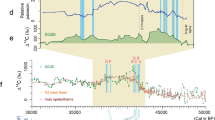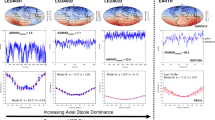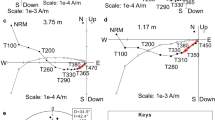Abstract
Palaeopoles from the Keweenawan (1,200–1,000 Myr) rocks of the Lake Superior region form the western and eastern arms of the ‘Great Logan Palaeomagnetic Loop’1,5 (Fig. 1a). This is defined by both normal (N) and reversed (R) poles which are the consequence of at least two geomagnetic reversals4,6,7. The younger one (R→N) has been detected throughout the Lake Superior region from various rock types.1–6 The older reversal (N→R) is only recorded in the lowermost Keweenawan lavas in the southern part of the lake.8 Wherever found, the reversals depart from the 180° symmetry (Fig. 1a)2–6. Due to these asymmetries, the Logan Loop has large segments that are devoid of data and thus the geophysical interpretations of the Loop (or ‘hairpin’) critically depend on the cause of the reversal asymmetry.4 Four models11 (secondary component6, apparent polar wander1–5, Wilson's dipole offset5,7,9 and non-dipole field configuration1,3,10) have been put forward to explain the asymmetries. Here we demonstrate that the two-dipole field configuration model can explain the reversal asymmetries and discuss the global effects of this model in the light of worldwide late Precambrian palaeomagnetic data.
Similar content being viewed by others
Article PDF
References
Robertson, W. A. & Fahrig, W. Can J. Earth Sci. 8, 1355–1372 (1971).
DuBois, P. M. Bull. Can. geol. Surv. 71, 1–75 (1962).
Pesonen, L. J. Bull. geol. Soc. Finl. 51, 27–44 (1979).
Pesonen, L. J. & Halls, H. C. Can. J. Earth Sci. 16, 2136–2149 (1979).
Robertson, W. A. Can. J. Earth Sci. 10, 1541–1555 (1973).
Palmer, H. C. Can. J. Earth Sci. 7, 1410–1436 (1970).
Pesonen, L. J. thesis, Univ. Toronto (1978).
Books, K. G. U.S. geol. Surv. Prof. Pap. 600 -D, 245–254 (1968).
Wilson, R. L. Geophys. J. R. astr. Soc. 28, 295–304 (1972).
Massey, N. W. D. Can. J. Earth Sci. 16, 373–375 (1979).
Palmer, H. C. et al. Can. J. Earth Sci. 18, 599–618 (1981).
Nevanlinna, H. J. Geomagn. Geoelectr. 32, 483–506 (1980).
Watkins, N. D. & Richardson, A. in Proc. of the Takesi Nagata Conf., 145–171 (1974).
Harrison, C. G. A. & Ramirez, E. J. Geomagn. Geoelectr. 27, 139–151 (1975).
Coupland, D. H. & Van der Voo, R. J. geophys. Res. 85, 3529–3548 (1980).
Piper, J. D. A. & Stearn, J. E. F. Phys. Earth planet. Inter. 14, 345–358 (1977).
McElhinny, M. W. & Merrill, R. T. Rev. Geophys. Space Phys. 13, 687–708 (1975).
Berger, G. W. et al. Nature 277, 46–77 (1979).
Watts, D. R. et al. J. geophys. Res. 85, 5316–5333 (1980).
Hubbard, T. P. thesis, Univ. Liverpool (1971).
Carmichael, C. M. Earth planet. Sci. Lett. 3, 351–354 (1968).
Piper, J. D. A. Geophys. J. R. astr. Soc. 40, 313–344 (1975).
Roy, J. L. & Robertson, W. A. J. geophys. Res. 83, 1289–1304 (1978).
Vlasov, A. Ya. & Popova, A. V. Izv. Earth Phys. 2, 63–70 (1968).
Elston, D. P. & Grommé, C. S. EOS 60, 236, (1979).
Elston, D. P. & Bressler, S. L. J. geophys. Res. 85, 328–339 (1980).
Author information
Authors and Affiliations
Rights and permissions
About this article
Cite this article
Pesonen, L., Nevanlinna, H. Late Precambrian Keweenawan asymmetric reversals. Nature 294, 436–439 (1981). https://doi.org/10.1038/294436a0
Received:
Accepted:
Issue date:
DOI: https://doi.org/10.1038/294436a0
This article is cited by
-
No asymmetry in geomagnetic reversals recorded by 1.1-billion-year-old Keweenawan basalts
Nature Geoscience (2009)
-
In GAD we trust
Nature Geoscience (2009)



